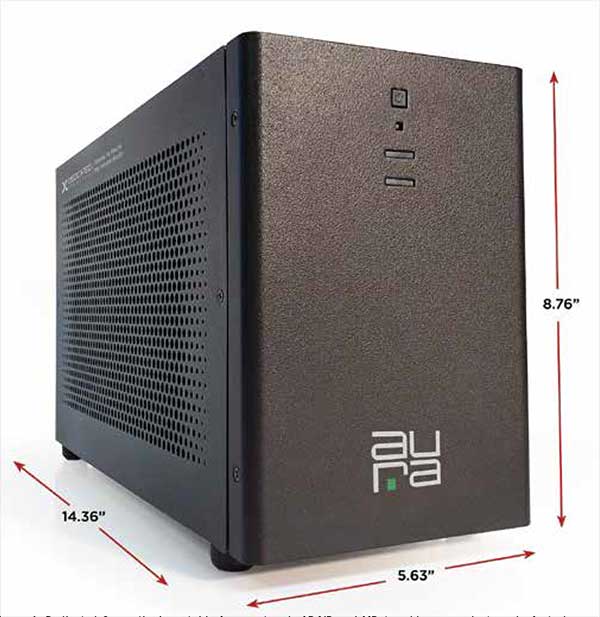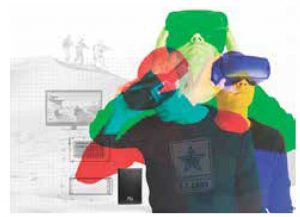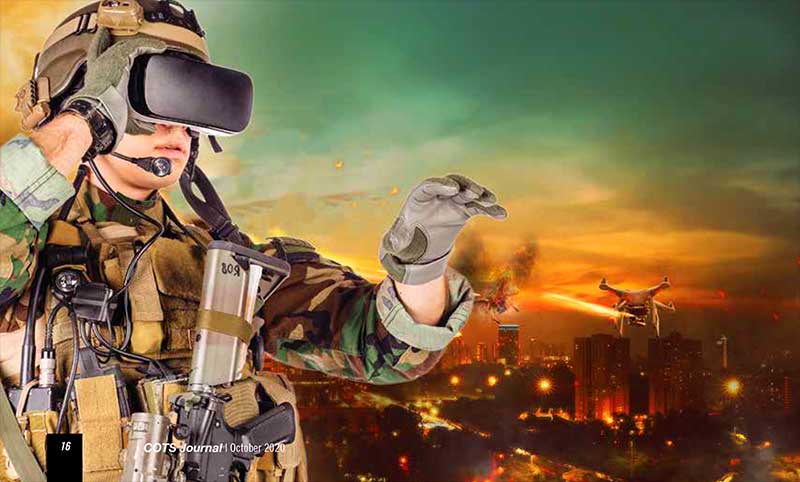Transportable Performance Advances Access at the Point of Need
Compact tech and distributed systems enable interoperable, mobile options for immersive LVC training
The shift to transportable systems has the potential to reshape the training and simulation landscape for the modern military. These flexible, durable systems bring high performance to the point-of-need, making a difference in convenience, cost, accessibility, and results. Increased flexibility is an essential driver in the spectrum of training and simulation initiatives across the armed forces – including the U.S. Army’s Synthetic Training Environment (STE), or programs from Naval Air Warfare Center Training Systems Division, a division of NAVAIR tasked with ‘the full range of research and development in support of Naval training systems for all warfare areas and platforms.’
These comprehensive programs build on the government’s Cloud First initiative established nearly a decade ago, treating training as a service and charged with more effectively bringing it to the point-of-need. Such initiatives shift the focus away from hardware and its associated maintenance, reducing costs and hardware footprint, and achieving highly flexible and scalable training capabilities. For military leaders, these are the advances helping to increase mission readiness for soldier, sailor, airman, or Marine, no matter the environment or geographic location. For the original equipment manufacturers (OEMs) of training systems, it means focusing on modular, small footprint systems that scale down infrastructure while advancing crucial capabilities like high performance scene generation for live-virtual-constructive (LVC) training. Today this approach also considers health risks and social distancing needs – a full training staff may not need to be onsite. Smaller systems allow trainees more room to spread out, and training systems delivered for small class groups are ideal for temporary or extended use.

Portable training and simulation is both distributed and centralized
A distributed training environment is capable of connecting multiple simulation devices to a single, centralized database without slowing performance, even while scaling to accommodate varying requirements for numerous users. OEMs must embrace a building block strategy, assessing elements such as storage, compute processing, image rendering, display, and network architectures against real-world needs for secure mobility and delivery of content. Today this means augmented and virtual reality (AR/VR) featured in LVC training applications, accessed by users via compact, configurable, portable classroom training systems. In these more compact systems, applications are driven with data from a single source rather than multiple locations. Further, training instructors are empowered to make application changes and improvements in real time via access to the same centralized infrastructure.
Bringing image rendering closer to the display
The building block strategy is valuable because of the diverse types of training applications and the need for continuous adaptation of system performance. To that end, the distributed network training infrastructure is constructed in layers that encompass network execution modeling, decisions, and higher-level collaboration. Architecture changes are fundamental: OEMs may opt to define one system as the rendering farm used universally by any client on the network, while another holds the software architecture that allows access to specific data used client-by-client. By enabling image rendering to operate closer to the display, data transmission costs are reduced, and technology remains more adaptable to the continued performance evolution of training applications.
Transportable systems are key enablers of distributed training
A small system footprint is a key enabler of a distributed approach, trading a field of rackmount servers for an individual PC positioned directly on the trainee’s platform. Combining high performance processors and graphics cards (GPUs) to produce a powerful, small form factor simulation engine, these lightweight, portable systems can be shipped from training site to training site. Small but powerful, these systems virtualize simulated elements into an AR/VR headset, for example, the avionics controls and display of a military aircraft or the steering wheel, dashboard, and window views for the driver-trainee of a military ground force vehicle. Systems and their accompanying costs are downsized for operators and, with a comparatively simple change of software, the same compute and hardware technology can be used to offer training on numerous types of equipment. The key is to ensure the necessary compute horsepower to drive the AR/VR headset, resulting in truly immersive study – no matter the end-use equipment or application.

Distributed training in action
One aerospace leader offers point-of-need training via a compact solution in a standardized shipping container measuring ~8×40 feet. The container can be trucked to its location and easily stored onsite, optimized for use where larger-scale training facilities are impractical due to space constraints or the need for flexibility. For example, on-demand training can be easily positioned in pier or port locations, convenient for service members and solving accessibility challenges in areas where installing classroom training facilities proves difficult. Most importantly, the power and performance of this container-based solution are not sacrificed as a trade-off for its compact footprint – system capabilities typically only available in racks of larger systems are delivered in a portable setting in a system under a half cubic foot in size. This small footprint system drives multiple monitors and AR/VR headsets. It is intentionally designed for scaling up with the size of the training class, eliminating the need to adapt the computer systems to different training applications. The same hardware can manage a variety of training needs – systems are extensible to handle Integrated Air & Missile Defense (IAMD), Anti-Submarine Warfare (ASW), Anti-Surface Warfare (SUW), and Fleet Readiness. The container-based system is also interoperable, for example connecting its compute systems with elements such as a field mission as part of an LVC exercise. This also adds value across military branches, readily connecting training scenarios that may involve National Guard, Navy personnel offshore, or airborne Air Force teams.
The system itself is also designed to address longevity concerns common in most military applications. Lifecycle management is handled through partnership with the system’s original design manufacturer (ODM), committing to strategies for hardware selection that balances price, performance, and scalability for critical areas such as CPU, memory, storage, and GPU. For example, this platform is deployed to accommodate both commercial and enterprise component options, acknowledging that GPU strategy may vary depending upon the training provider’s product roadmap. Commercial GPUs such as Nvidia®’s GeForce® may be preferred, with updates every 12 months or less, or enterprise-class, such as Quadro® options, may be favored based on an available three-year lifecycle. In this case, the ODM also worked with the training provider during the software development phase, collaborating to optimize performance and determine specific application features handled by the GPU rather than CPU.
In contrast to facilities where the compute systems are racked and perform behind the scenes, in this container-based setting, they are operating directly at the student’s station or as part of the onsite image render system. Because of this, visual appearance matters and directly represents the product image and sophistication of the training provider. Acoustic output is a consideration, as noise level of the compute system must not distract the trainee from the audio of the training program itself.
In this scenario, system mounting is flexible and may be placed on the back of a display or directly on a student’s workstation. Image render node, networking, and system architecture work together to ensure images and applications are served without latency. Scalability is a factor and the system handles multiple training scenarios; container trucks can be large or small, intended to handle larger or smaller groups of trainees using the same hardware architecture. As a vehicle for training as a service that is truly on-demand, the shipping container can be moved from point to point, either trucked or trailered across land or transported on a shipping vessels for less accessible locations. Its transportable design minimizes weight and freight costs and includes advanced component retention that promotes stability of the platform during transport.
Small footprint, big performance
Training and simulation markets are shifting perspective, re-imagining existing high-end simulation solutions as more portable and flexible. Whether training how to steer a ship or maneuver a military ground vehicle, these compact systems for LVC training tools offer safe, real-world experience via stair-stepped protocols that build on each level of skill. Today system operators are poised to scale solutions to accommodate greater diversity – from full flight simulation to driving sophisticated ground vehicles to operating naval ships like frigates, destroyers, cruisers, and carriers.
Small system footprint is a key enabler to this approach, replacing a field of rackmount servers with an individual PC positioned directly on the trainee’s platform. Blending high performance processors and graphics cards to create a powerful, small form factor simulation engine, these lightweight, portable systems can be transported from training site to training site. It is a shift that represents a new mandate – balancing high performance image rendering in a small footprint for flexible, safe systems that accommodate diverse training needs now and into the future.

